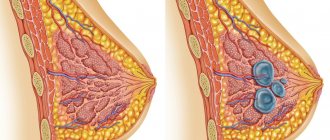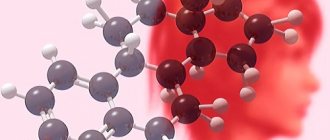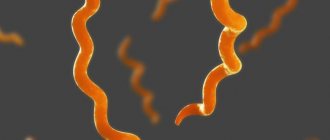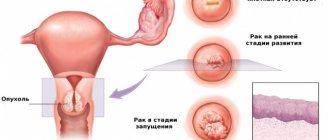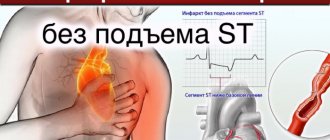First signs of ovulation
The first signs of ovulation are short-term nagging pain in the lower abdomen. The first signs of ovulation include an increase in mucous secretions and a decrease in basal temperature on the day of ovulation, and its increase the next day. The content of progesterone in the blood plasma increases sharply. If ovulation is disrupted, the first signs of ovulation will not make themselves felt. This can be caused by inflammation of the genital organs, systemic diseases, tumors or stressful situations. In this case, dysfunction of the hypothalamic-pituitary-ovarian system occurs in the female body. If the first signs of ovulation do not make themselves felt during childbearing, adulthood, then the female body is faced with anovulation, which occurs along with a disruption of the menstrual cycle and dysfunctional uterine bleeding. In addition, the absence of the first signs of ovulation may indicate that a woman is infertile. But there are methods that will help determine the reason for the lack of ovulation and return it. But first of all, you need to contact a gynecologist.
Signs of the onset of ovulation
Signs of the onset of ovulation help a woman better understand her body and choose the ideal time for sexual intercourse, which will contribute to the long-awaited conception and pregnancy. Signs of the onset of ovulation:
- Discharge - changes occur in the cervical mucus, its consistency and amount of discharge changes. Such changes indicate increased estrogen levels. When the mucus becomes similar to raw egg white, this is the first sign that ovulation has begun and the woman is ready to conceive.
- Basal temperature - before ovulation, a woman's basal temperature rises. This can be determined with a thermometer in the morning before you get out of bed. A sharp rise in temperature indicates that the egg is already mature and ready for fertilization. A couple of days during which the basal temperature level is high is the ideal time for conception. To better navigate the signs of ovulation, using basal temperature measurements, you can create a graph that will clearly show approaching ovulation and the time for conception/conception.
- Well-being - another sign of ovulation is pain in the lower abdomen. For some women, the pain lasts a couple of minutes, for others for several days, and for others, the entire period before the onset of menstruation resembles cramps. By the way, pain in the lower abdomen does not occur in all women, so if you did not have pain and suddenly suddenly appeared, then consult a gynecologist, as this may indicate a pathology or some kind of disease.
- Hormones - before ovulation begins, significant hormonal changes occur in the female body. The production of luteinizing hormone increases. You can determine the onset of menstruation using special tests that are sold in pharmacies. The tests work on the hormone described above, or more precisely on its interaction with the reagent.
Signs of approaching ovulation
Signs of approaching ovulation make it possible to understand that the body is ready to conceive a child. Let's look at reliable signs of approaching ovulation, which are found in almost all healthy women.
- Breast swelling.
- High energy.
- Headache.
- Emotionality and irritability.
- Increased sexual desire.
- Swelling.
- Changing allocations.
- Enhanced vision, taste and smell.
- Bloody issues.
These are all signs of ovulation. But do not forget that the signs of approaching ovulation depend entirely on your lifestyle. Try not to be nervous, eat healthy foods, have regular sex life and an active lifestyle. Then the signs of ovulation will not be so painful.
Signs before ovulation
Signs before ovulation help a woman plan a pregnancy or, conversely, pay attention to contraceptive methods and check her ovulation calendar. Let's look at the main signs before ovulation.
- Pain in the lower abdomen - pain occurs on one side, on the side where the ovary is located, which is preparing for ovulation. As for the duration of pain, it can be from a few minutes to 3-4 days.
- Swelling and tenderness of the breasts is the surest sign that indicates that a woman will begin ovulation in the near future. Breasts become very sensitive and swell due to changes in hormone levels in the body, which is preparing for conceiving a child.
- Vaginal discharge changes, it becomes abundant and watery.
- Basal temperature increases due to the hormone progesterone.
- Sexual desire increases. This is a signal from the body that the woman is healthy and ready to conceive a child.
- The cervix becomes soft, rises and dilates slightly. This is necessary for conception to be successful.
Also, signs before ovulation include increased taste and smell. This occurs due to an increase in the level of the hormone progesterone and changes in hormonal levels in the female body. Sometimes, before ovulation, there may be slight bloating and flatulence, but in addition to approaching ovulation, this indicates a woman’s poor diet and lifestyle.
External signs of ovulation
During the period of ovulation, not only the state of a woman’s body changes, but also her appearance, that is, there are external signs of ovulation. Every woman should listen to herself and her body in order to navigate the signs and signals that the body gives.
The following external signs of ovulation are distinguished:
- Increased sexual desire.
- Breast swelling.
- Pain in the lower abdomen.
- Changes in mucous secretions.
- Increased fatigue, sudden mood swings, tearfulness.
Pay special attention to vaginal mucus, it resembles egg white, becomes more viscous, and increases significantly with discharge.
Signs of ovulation
The signs of ovulation appear differently for each woman, but they all indicate that the woman has a healthy body that is ready for procreation. Let's look at the signs of ovulation that occur in every woman.
- Changes in basal temperature - Check your basal temperature every morning before you get out of bed for a couple of cycles. Use your results to create a graph. Using the graph, you can determine the onset or end of ovulation. So, an increase means that ovulation has occurred, and a decrease means ovulation has ended. Changes in basal temperature are associated with changes in the level of the hormone progesterone. It is this hormone that is responsible for the restructuring of mucous secretions and for the implantation of a fertilized egg in the uterus.
- Discharge is the surest sign of ovulation. Heavy discharge begins a couple of days before the release of the egg; it looks like egg white. Changes in secretions are necessary not only to determine the onset of ovulation, but also to increase the life cycle of sperm.
- Changes in the cervix - Signs of ovulation begin with changes in the cervix. It rises and opens a little, and becomes soft to the touch. After ovulation and the release of the egg from the follicle, the uterus closes and descends.
- Drawing pain - pain appears in the chest, lower abdomen and lower back. They go away immediately after ovulation ends. Some women experience pain so severe that it is very difficult to survive the ovulation period without painkillers and bed rest.
- Ultrasound examination allows you to accurately determine the beginning of ovulation and its end.
Ovulation and discharge
Signs of ovulation can be easily determined by the discharge. To do this, a woman must know the features of the first and second phases of the menstrual cycle. Signs of ovulation based on discharge depend on the moment of the cycle. Signs of ovulation and discharge can make it clear whether a woman is pregnant or not, whether ovulation has ended or is it just beginning; the main thing is to carefully monitor the state of your own body. •
After menstruation, there is practically no discharge, but closer to the middle of the cycle, heavy discharge appears, at first it is liquid, and then becomes creamy and sticky. All this is directly related to the level of hormones in the female body and the slow dilatation of the cervix.
- On the day of ovulation, the discharge is a viscous, sticky mucus, sometimes with lumps. This consistency of mucus is provided by the body so that sperm can get to the egg as quickly as possible.
- Sometimes the mucus has pink streaks, white, yellow or brown. This color of discharge indicates the end of ovulation.
- Some women also experience spotting, which is accompanied by pain in the lower abdomen, usually on the side where the ovary is located, in which ovulation occurs.
- There are cases when ovulation occurs without discharge. The reasons may be the stress and nervous state that the woman suffered or one of the phases of ovulation that failed.
Ovulation and bleeding
Some women experience bleeding during ovulation. As a rule, there are few of them and they are brown or yellow-brown in color. This frightens many and causes panic attacks, and thoughts that signs of ovulation and bleeding are associated with implantation bleeding. But this is far from true. About a week passes between ovulation and the period of implantation, so you should not associate spotting and bleeding due to implantation.
The reason for bleeding during ovulation is a rupture of the follicle, which will soon release mature eggs. With the arrival of menstruation, the ovaries release mature eggs, which are located in peculiar follicle capsules. After some time, out of all the follicles, only one remains, in which the mature egg is located. It is because of the rupture of the follicle in the ovary that bleeding appears. Similar discharge is observed for two days, no more.
Ovulation and mucus
Before ovulation, the female body produces cervical mucus, which acts as a natural remedy for effective conception. Mucus creates an ideal environment for sperm. In a healthy woman, sperm will live for about 72 hours. If there are no signs of ovulation and mucus, then the life of sperm will be reduced to a couple of hours.
Thanks to mucus, a unique environment for sperm is formed in the vagina, which allows them to move much faster into the vagina, which means they can fertilize the egg faster. As for the amount of mucus, it is different for everyone. The closer ovulation is, the more mucus, but a couple of days before ovulation begins, the amount of mucus decreases, and after ovulation ends, the mucus disappears.
Please note that even a small amount of mucus is a sign of the fertile phase. At first, the discharge looks like cloudy mucus, but as ovulation approaches it becomes slippery, viscous, transparent, and sticky. And after ovulation, the mucus becomes thick and cloudy and disappears. After this, the mucus begins to dry out in the female body and the infertile period begins.
Do your breasts hurt during ovulation?
All women experience the same sign of ovulation - breast pain. The breasts swell, become very sensitive, and hurt at the slightest touch. Such signs of ovulation are observed on the 15th day of the 28-day menstrual cycle. Signs of ovulation - breast pain, which can occur after menstruation.
Pain sensations in the mammary glands change cyclically due to the influence of female hormones - progesterone and estrogen. Due to the growth of estrogen in the female blood, the breasts begin to hurt; as a rule, the pain indicates that in a couple of days the woman will begin menstruation. For many women, breast pain as a sign of ovulation determines the most favorable period for conceiving a child. Gynecologists call chest pain a sign of ovulation - premenstrual syndrome or PMS. The appearance of pain a couple of days (from 2-3 to two weeks) before the onset of menstruation indicates that ovulation has occurred in the female body.
Signs of ovulation on ultrasound
Signs of ovulation on ultrasound allow you to accurately determine the phase of ovulation. With the help of ultrasound, you can create a personal ovulation schedule and calendar, as well as find out about the approaching or end of ovulation.
The following signs of ovulation on ultrasound are distinguished:
- Growth of the follicle with the egg, dilation of the cervix.
- Visualization of the grown follicle to ovulatory size.
- Observation of the corpus luteum, which is located at the site of the follicular fluid and follicle. The presence of fluid indicates that the follicle has successfully released the egg and ovulation has begun.
Also, signs of ovulation can be determined by ultrasound using the hormone progesterone. Progesterone is checked in the second phase of the cycle, that is, a week after ovulation or a week before the start of menstruation. If progesterone is normal, or preferably above normal, then ovulation was 100%, if below normal, then there was no ovulation. But there are exceptions, this happens when the follicle does not burst due to the very thick lining of the ovary and the egg does not get out. An ultrasound will determine this due to free fluid in the peritoneum.
Libido and ovulation
The desire for intimacy is a very common sensation during ovulation. Most often, an increase in libido is observed before ovulation, when LH and estradiol increase. During the same period, the consistency of cervical mucus changes and the woman feels constant moisture. As a result, sexual desire arises.
Note(!) If there is more cervical fluid and it has acquired the structure of crude protein, and you also feel an increased sexual mood, this almost certainly indicates that ovulation is approaching. The most favorable period for successful conception has arrived. It's time for intimacy.
Ovulation period
The ovulation period is the day in the cycle when conception will be most effective and will lead to pregnancy. That is why all women who are trying to get pregnant carefully calculate this date. Or, on the contrary, they protect themselves as much as possible on this day, since the likelihood of pregnancy is high. Ovulation and the period of ovulation are clear signs that the female body is functioning correctly and is ready to give another life. Let's look at how to calculate the ovulation period, signs and main symptoms.
Calendar method. A method used by women to use a calendar to regularly mark the onset and end of their menstrual cycle. This allows you to calculate the length of the menstrual cycle. To accurately find out the period of ovulation, you need to regularly keep a calendar of the onset and end of menstruation for 4-5 months, and then carry out small calculations. For example, your average cycle is 28 days, then the ideal day for ovulation is 15-16. But do not forget that the egg does not mature every month; there are months in which there is no ovulation at all. There are other methods that allow you to quickly and more reliably find out about approaching ovulation.
Ovulation period, signs:
- An elevated basal temperature indicates approaching ovulation.
- Breast swelling, breasts become very sensitive.
- Changes in mucous secretions.
- Hypersensitivity, irritability, increased emotionality.
- Increased libido, strong sexual desire.
Yandex.Direct
How to determine ovulation?
There are several methods to determine ovulation. Every woman who is sexually active and wants to get pregnant needs to be able to determine ovulation. But how to determine ovulation in order to protect yourself from unwanted pregnancy or, on the contrary, do everything so that conception leads to pregnancy?
- Determining ovulation by measuring basal temperature. In the first half of the cycle, thanks to estrogen, the readings on the thermometer will be low, around 36-36.5 degrees. But before ovulation, the temperature will increase to 37 degrees due to the high concentration of the hormone progesterone.
- To determine ovulation, you can do a special test and closely monitor your vaginal discharge. Before ovulation, they become abundant, transparent, and sticky.
- The calendar method, like measuring basal temperature, requires time and observation. Using the calendar, you can find out about your upcoming cycle and ovulation.
- Tests - There are tests not only to determine pregnancy, but also to determine ovulation. In cost they are equal to pregnancy tests, but their popularity will soon supplant them. Diagnosis using an ovulation test, as well as a pregnancy test, is made using urine. Two lines on the test - the period of ovulation. The test works thanks to luteinizing hormone, which predicts the period of ovulation.
- Ultrasound examination - used in cases where ovulation does not occur for a long time, there was a malfunction in the body that led to a complete change in the cycle. During the procedure, the doctor monitors the period of follicle development. If the follicle has not burst and released a mature egg, then a small amount of fluid is observed in the abdominal cavity.
- Feelings - you can determine ovulation by your own feelings. So, the most obvious sign of ovulation is pain in the lower abdomen. The pain can last from a couple of minutes to several days, it completely depends on the woman’s body.
The ovulation period is the ideal time to conceive a child.
Nausea during ovulation
There are several possible reasons for this.
- The first: increased production of prostaglandins, which causes blood vessels and smooth muscles to become vascular - hence nausea during ovulation.
- Second: hormonal imbalance, a sharp jump in testosterone (at the same time it increases libido).
- Third: physiological reasons - scars, sutures in the pelvis, on the uterus, ovaries, tubes. At the time of ovulation, the pelvic organs are intensively supplied with blood, enlarge and put pressure on the receptors of the abdominal cavity, causing nausea.
However, nausea cannot be considered as a separate 100% symptom of ovulation, but only in combination with other signs. Moreover, nausea will certainly be repeated from cycle to cycle.
From experience(!), for example, I always feel a little nauseous on the day of ovulation, no matter what I ate today. I attribute this to the first reason. I felt even more nauseous during both births, and much less pronounced nausea occurs after intimacy (with female satisfaction). All these processes are associated with the active production of prostaglandins.
Signs of double ovulation
There are cases when a woman has two ovulations in one cycle. Ovulation can take place either in one ovary with a break of several days or in two ovaries at the same time. This phenomenon occurs after induction and stimulation of ovulation, but sometimes also in normal cycles.
Scientists say that there are only a couple of cases in the world when, due to double ovulation, double pregnancies occurred with a difference of several days, but no more than 10. But many gynecologists say that double ovulations are much more common and the woman does not always know about it.
The following are signs of double ovulation:
- Breast swelling.
- Changing allocations.
- Pain in the lower abdomen (first on one side, then on the other, or on one side for a short period).
Please note that ovulation does not always occur alternately in the ovaries. There is no systematization of ovulation. In the female body, one ovary acts as the main one and ovulates; this can be observed over several cycles. But such a picture does not mean that the second ovary is sick and requires immediate medical attention. The hormone pattern is responsible for the sequence of ovulation in the ovaries and nothing and no one can influence it. Therefore, you should not be surprised if during one cycle you notice increased or repeated signs of ovulation.
Test strips for determining ovulation
The easiest way to determine ovulation is to use special test strips that detect high levels of luteinizing hormone in a woman’s body and signal the onset of a fertile period. Most tests are presented with paper or plastic strips; more expensive options are equipped with a digital display.
Manufacturers advise not to urinate 4 hours before testing to ensure sufficient levels of the hormone are concentrated in the urine. Therefore, many women prefer to use strips in the morning.
If the result is positive (increased levels of luteinizing hormone), the test strip will take on the same color or slightly darker as the control. Typically, ovulation occurs 1-2 days after the level of luteinizing hormone begins to increase. This period of time is the most favorable for conceiving a child.
The start of testing depends on the cycle length:
Knowing how the body works is important for any person, woman or man. But most often women think about this, because the female body has a unique function - childbearing. And for this function to work, you need to know what ovulation is - signs, symptoms, sensations. Let's look into this issue.
Signs of late ovulation
Signs of late ovulation frighten women, as many people think that if ovulation occurs later than usual, then there is a disorder or disease in the body. But is it? Let's look at the causes and signs of late ovulation.
- Overwork, stress - if a woman is planning to conceive a child, then she is strictly forbidden to be nervous. Changing climatic conditions and frequent flights from one time zone to another are also not recommended. Try not to overwork yourself, both physically and mentally. Since overwork is the most common sign of late ovulation.
- Infectious diseases - if there is an infection in the female body that concerns the reproductive system, then late ovulation is inevitable. In addition, due to infection, the menstrual cycle is disrupted and there may be a delay, which for many women is a reason to think that pregnancy has occurred.
- Hormonal Imbalance – Imbalance of pituitary hormones is another sign of late ovulation. In order to find out the ovulation status, it is recommended to measure hormone levels in the first phase of the cycle.
- Premenopausal period - late ovulation is observed in women who are forty or more years old.
- Gynecological diseases - infections, cysts, amenorrhea.
- 2-3 months after an abortion and 1 year after childbirth - during this period the woman will have late ovulation.
Late ovulation can be determined using an ovulation test, a full diagnosis and ultrasound examination of the release of the egg from the follicle, and tests for the level of pituitary hormones. Please note that it is best to conduct research into the cause of late ovulation during the period of the desired conception of a child.
To speed up the process of ovulation, it is recommended to contact a gynecologist, take the necessary tests and undergo an examination. After this, the doctor prescribes treatment for late ovulation or stimulates the onset of ovulation in its absence. This is the simplest and most effective solution to the problem of late ovulation. Do not self-medicate, as this can cause problems for both the unborn baby and the mother.
When treating problems with ovulation, it is necessary to lead a healthy lifestyle, be less nervous, eat healthy foods, and lead an active lifestyle. Regularly have sex with a regular partner without protection.
How to make an ovulation calendar and make calculations
Every girl and woman should exercise control over her own menstrual cycle and the normal course of natural processes. It is important for a quick response to possible pathological changes in the body, because they can be the result of serious diseases.
It is necessary to keep a calendar to mark the first days of the beginning of menstruation. In this case, the following points are controlled:
- regularity of the cycle - the duration should be the same, deviations are allowed only up to two days;
- length – the number of days between the first numbers is calculated; 28 days is considered normal;
- how many days does menstruation last? Everything is normal if it occurs the same way in each period - we are talking about the abundance, nature and duration of the discharge.
Signs of conception
Signs of conception manifest differently in every woman. So, some women begin to understand that they are pregnant after a week, others after a month, and some even only after going to the gynecologist and taking a test. Let's look at the main signs of conception.
- Signs of conception in the first days are bleeding. After conception, somewhere in the first or second week, the process of embryo implantation occurs in the body. For many women, this period is accompanied by bleeding and cramping.
- The menstrual cycle is disrupted, in other words, the woman has a delay. This is the most common sign of conception. During pregnancy, the menstrual cycle stops, but some women may experience light bleeding.
- Sensitive breasts. A couple of days after conception, the breasts swell and become hypersensitive. This is a sign of conception that cannot be ignored, since even a light touch to the breast causes discomfort.
- Nausea is also a sign of conception and occurs from 3-9 weeks after conception.
- Apathy and fatigue. Due to the fact that the body is being rebuilt to support the life of mother and child, the expectant mother may feel unwell from the first days of conception.
- Headache - appears in the first days of conception and occurs due to changes in the hormonal levels of the female body.
- Frequent urge to go to the toilet. Frequent urination appears at 6-7 weeks of conception.
- Increased appetite - after conception, a woman begins to feel constant pangs of hunger. As for products to satisfy such an appetite, these are not necessarily pickles. By the way, this symptom can persist throughout the entire period of pregnancy.
Signs of conception after ovulation
During ovulation, a woman has several days to become pregnant. That is, in the fertile phase of ovulation, successful conception is most likely. Signs of conception after ovulation look like this:
- Lack of menstrual cycle.
- Increased basal temperature.
- Increased appetite and changes in taste preferences.
- Vomiting, diarrhea, nausea.
- Breast swelling and tenderness.
- Strong sense of smell.
- Irritability.
- Apathy and fatigue.
- Change in vaginal discharge.
Please note that the lifespan of sperm in a healthy woman is from 3 to 7 days, but if there are disturbances in the female body, especially if they relate to vaginal discharge, then the likelihood of conceiving a child is reduced to a couple of hours.
If a woman has disturbances in the process of maturation of the follicle, which is responsible for the egg, then it is necessary to stimulate ovulation. For these purposes, you need to undergo an examination and consultation with a gynecologist, who will prescribe medications to restore ovulation and the possibility of conception.
How to “catch” ovulation?
If you want to make sure that you are ovulating, you can measure your basal temperature . It is measured rectally.
Since changes in basal temperature are caused by many factors, there are strict rules for measuring:
- The most important condition: basal temperature must always be measured at the same time, the maximum difference can be half an hour,
- It is necessary to take measurements in the morning at rest, before getting out of bed; you should also not sit down before taking measurements.
- It is necessary to hold the measuring device for at least 5-7 minutes;
- readings must be taken immediately after removing the thermometer - and recorded in the chart. It is also important to note the probable reasons for the change in BT - for example, a recent cold. Be sure to show the schedule to your doctor.
- It is necessary to measure BT every day, at least 3-4 cycles in a row.
Changes in basal temperature are important signs because they occur during the cycle with a certain sequence. If at the very beginning of the cycle it decreases, then closer to the onset of ovulation, on the contrary, it increases.
Therefore, if you carefully monitor changes in BBT by keeping a chart , you will be able to understand on which days you are most likely to conceive a child.
If you do not have the desire or ability to maintain such a schedule, then you can purchase a special test at the pharmacy that determines ovulation .
Using this test, you can determine the presence of LH (luteotropic hormone) in the urine, the increase of which is responsible for ovulation.
For women with an established regular cycle, it is enough to do the test for about 5 days .
To understand what day to start testing, you need to subtract 17 from the total number of days of the cycle.
- It is important to conduct testing every day, at the same time,
- Do not use the first morning urine when testing - since LH begins to form in the female body in the early morning, its concentration will increase throughout the day.
- It is advisable to drink less fluid before the test.
How to correctly calculate ovulation with a regular cycle using a calculator?
If none of the above methods suits you, then you can use a special online ovulation calculator .
You will need to indicate in the calendar the date of the first day of menstruation, the duration of the menstrual cycle in days, the duration of menstruation (in days).
The calendar will automatically calculate which day of the cycle ovulation may occur.
Signs after ovulation
- Signs after ovulation are very difficult to track, but the best way to do this is with an ovulation test or an ovulation calendar.
- The first sign after ovulation is discharge; it is either completely absent or becomes creamy and sticky.
- Also, after ovulation, the basal temperature does not fall and is in an elevated state. This is also observed in the case of pregnancy, when the egg is fertilized.
- After ovulation, the pain and swelling of the mammary glands goes away, and the pain in the lower abdomen also stops.
- Another sign after ovulation is the disappearance of the hormonal rash. As a rule, before ovulation, small hormonal pimples appear on the face, especially on the forehead.
All signs after ovulation depend on how the ovulation process itself went and, of course, on the individual characteristics of the female body.
Signs of pregnancy after ovulation
All women have a couple of days before and after ovulation, called the fertile phase. These days are the most favorable moment for conception and pregnancy. Let's look at the main signs of pregnancy after ovulation.
- High basal temperature.
- Delayed menstruation.
- Swelling and change in breast shape, darkening of the nipples.
- Increased fatigue, morning sickness, sudden and causeless mood swings.
- Change in vaginal color.
- Frequent urge to go to the toilet and increased mucous discharge.
- Bloody discharge, gas and constipation.
- Spasms in the lower abdomen may be on one side.
- Heightened sense of smell.
- Acne and pimples.
- Mild cold and stuffy nose.
- Changes in taste and increased appetite.
Signs of fertilization after ovulation
Signs of fertilization after ovulation appear no earlier than a couple of weeks after intercourse. Let's look at the signs of sexual fertilization after ovulation.
- Implantation bleeding, which is caused by the attachment of the embryo to the uterine cavity. Bleeding occurs within one day or several hours.
- The breasts swell and become very sensitive.
- Menstruation does not occur, that is, there is a delay.
- There may be a feeling of nausea, apathy, headache, and fatigue.
- There is frequent urination and uncontrolled appetite.
All these signs are conditional and they can be caused by other reasons, for example, colds, infectious or inflammatory diseases. It is better to determine fertilization and pregnancy after menstruation has not occurred, that is, after a delay. About five weeks after sexual intercourse, at which time conception and pregnancy could occur.
How can you further determine ovulation?
In addition to the above calculations and observations, a woman can use additional methods that most likely allow her to determine the day of ovulation. In particular, these are:
- test strips;
- basal temperature;
- devices that analyze saliva;
- Ultrasound.
Test strips that detect ovulation
The use of such strips is perhaps the easiest method for determining ovulation. It allows you to recognize the increased level of luteinizing hormone in the body, which is a signal of the onset of the fertile period. There are paper, plastic test strips, and digital displays (the latter being a more expensive option).
To effectively test, you must not urinate for 4 hours: this way the corresponding hormone is concentrated as much as possible in the urine. Therefore, most women believe that it is best to use such strips in the morning after sleep.
If the result is positive and the hormone level is elevated, the test strip turns the same color or slightly darker than the control strip. As a rule, ovulation can be expected a maximum of 1-2 days from the beginning of the increase in luteinizing hormone levels. This period is most favorable for conception.
This option is the most correct and most accurate. However, we note that you should resort to it if you cannot independently determine the day the cell appears, for example, in case of irregular cycles, or due to the absence of symptoms corresponding to ovulation.
Then the doctor conducts an examination using ultrasound on the 7th or 9th day of the cycle. In particular, the process of follicle emergence and how quickly it grows is monitored.
Inspections for this purpose are scheduled every other day or two. When the follicle becomes the desired size, the doctor tells you the date of release of the cell and prescribes days for sexual intercourse that are optimal for conception.
Microscopes
This is a device for analyzing saliva. Such devices are much more convenient than the above test strips. But, of course, due to the fact that microscopes can be reused, their cost is not low. This option is for women who have difficulty determining the day of fertilization and, in fact, the process itself. The device helps you solve the problem using your saliva.
Such microscopes are convenient and easy to use. They are very compact and can be used anywhere: you just need to apply a smear of saliva to a glass slide and look at it through a microscope. When the wall of the follicle is ruptured, the microscope shows a peculiar pattern in the form of a fern leaf: this image is formed by salts in saliva.
Basal temperature
Of course, drawing up such a schedule is a labor-intensive task. Rectal measurements should be taken every day and noted on the chart. The curve will show a decline before ovulation and will “go” up during the process of cell release.
Accordingly, a favorable moment will come during characteristic leaps. But it is worth noting that the measurements must be very accurate, since the range of “peaks” is only 0.4-0.6 degrees.
Signs of lack of ovulation
Signs of lack of ovulation appear in every healthy woman. As a rule, women under 30 years old have about 2-3 cycles per year with a complete absence of ovulation. Lack of ovulation is a symptom of gynecological or endocrine disorders that can lead to infertility. Let's look at the most common signs of lack of ovulation.
- Pregnancy and breastfeeding.
- Premenopause.
- Stop taking hormonal medications.
- Various diseases.
- Climate change.
- Intensified training.
- Stressful situations.
- Weight loss or gain.
There are many signs and reasons that indicate that there is no ovulation. Many signs of lack of ovulation depend on the period of a woman’s life, for example, adolescence, menopause, or breastfeeding and pregnancy. Other signs are associated with the use of hormonal and medications. Still others with diseases, sports and much more. To find out exactly what the body is saying when it shows certain signs of lack of ovulation, be sure to consult a gynecologist or undergo an ultrasound examination.
Signs of a cycle without ovulation
Signs of a cycle without ovulation or an anovulatory cycle are menstruation without the development of the corpus luteum, but with bleeding. This occurs due to the fact that the uterine mucosa grows, and the secretory phase, which occurs under the influence of the corpus luteum after ovulation, is absent.
A similar phenomenon occurs in healthy women, especially during adolescence, when the menstrual cycle is being established. Signs of a cycle without ovulation can occur in nursing mothers and during the onset of menopause, that is, menopause. The reason for a cycle without ovulation is insufficient stimulation of the ovaries by the hormones of the hypothalamus and high levels of the pituitary hormone.
The main signs of a cycle without ovulation are breast swelling, emotional changes, increased basal temperature, and changes in vaginal discharge. Please note that a cycle without ovulation is accompanied by a delay in menstruation from a couple of days to several months, and after this period comes long and painful menstruation with heavy bleeding. Heavy bleeding can lead to anemia. Signs of a cycle without ovulation are most often observed in women of childbearing age who have hormonal infertility precisely due to the lack of ovulation.
When does ovulation occur?
In 90% of women of childbearing age, the menstrual cycle lasts from 28 to 32 days and is divided into three main phases: follicular, ovulatory and luteal.
Follicular phase
The first phase begins from the onset of menstrual bleeding and lasts for 10-14 days. Under the influence of hormones in the ovary, a certain number of primary follicles are activated and their maturation begins. At the same time, the uterus begins to prepare for pregnancy, initiating the formation of a new layer of the endometrium.
During the last five days of the follicular phase, one (in rare cases two) of the follicles separates from the cohort and continues its maturation to a dominant state. It is he who will subsequently release the egg for its passage through the fallopian tubes and subsequent fertilization.
Ovulatory phase
The levels of luteinizing and follicle-stimulating hormones, which reach maximum values at the end of the follicular phase, lead to the rupture of the dominant follicle and the release of the egg from the ovary into the fallopian tubes, from where it begins its journey to the uterus with the help of cilia pushing it. At the site of the burst follicle, a corpus luteum forms, which begins to produce progesterone and prepare the uterine mucosa for possible pregnancy.
The timing of ovulation varies from cycle to cycle and woman to woman, but usually occurs 14 days before the next period. The fertile period, taking into account the lifespan of sperm and egg, ranges from 12 to 24 hours from the moment the egg is released. The exact time of ovulation can be determined by charting your basal temperature and using an ovulation calendar.
Signs of ovulation occurring
Signs of ovulation indicate that the female body is ready for fertilization or that menstruation will begin in the near future. The time of the beginning and end of ovulation is of great importance for women who want to get pregnant or, on the contrary, are protected naturally.
The main signs of ovulation occurring:
- Changes in discharge, that is, cervical mucus.
- Pain in the ovaries.
- Increase in basal temperature and body temperature in general.
- Changes in hormone levels (this sign is displayed on the face, in the form of a hormonal rash on the face).
To accurately understand the signals that the body gives and know the signs of ovulation, you can buy an ovulation test or keep a special chart that will help track the beginning and end of ovulation and monitor the features of the cycle.
Signs that ovulation has passed
Signs that ovulation has passed are as important as signs that ovulation has begun. The ovulation period is always accompanied by certain symptoms, which can be understood and studied only after observing your own body.
Signs that ovulation has passed:
- Change in vaginal discharge.
- Fluctuations in basal temperature, but as a rule, after ovulation has passed, basal temperature decreases.
- The pain in the lower abdomen, on the side of one of the ovaries, where ovulation occurred, stops.
- Decreased sexual activity and libido.
- Slight swelling of the mammary glands.
Signs of the end of ovulation
Signs of the end of ovulation indicate that if conception has not occurred, then the woman will begin menstruation in the near future. Let's look at the main signs of the end of ovulation.
- If pregnancy does not occur, then menstrual flow begins.
- At the end of ovulation, the level of basal temperature decreases.
- Hormonal levels are normalized, estrogen and progesterone are reduced to normal levels.
- Breast swelling and sensitivity goes away.
- There may still be pain in the lower abdomen.
- Irritability and emotional swings.
Monitor your body closely to understand when ovulation begins and ends. Make an ovulation calendar or buy a test to determine your ovulation periods. As a last resort, you can always consult a gynecologist and go for an ultrasound examination to determine the ovulation cycle.
Signs of completed ovulation
Signs of ovulation are very important, as they indicate the healthy reproductive function of the female body. In addition, ovulation is a signal from the body that it is ready for conception and pregnancy. Let's look at the signs of ovulation.
- A woman experiences a change in vaginal discharge; it becomes transparent, sticky and viscous. This consistency of the discharge indicates that the woman is ready for fertilization and, thanks to the mucus, sperm can quickly reach the mature egg.
- Basal temperature - before the onset of ovulation, the level of basal temperature rises, and if ovulation has taken place, then the basal temperature drops to the usual level of 36.4 degrees.
- During the period of ovulation, one of the ovaries hurts, that is, nagging pain appears in the lower abdomen. As soon as ovulation has taken place, the pain stops or becomes less severe.
- Signs of ovulation include a woman’s poor health, fatigue, apathy, irritability, increased emotionality, touchiness, and tearfulness.
To confirm the authenticity of signs of ovulation, it is recommended to undergo an ultrasound examination. An ultrasound will visually show whether ovulation has occurred or not.
Signs of ovulation are signals from the body that a woman is healthy and ready to reproduce. In addition, ovulation helps a woman maintain her beauty. Since ovulation is responsible for the menstrual cycle. If you have the slightest problem with determining the period of ovulation or the characteristics of the menstrual cycle, seek help from a gynecologist and undergo an ultrasound examination.
When does ovulation occur?
The menstrual cycle of most women of childbearing age lasts from 28 to 32 days, and it can be divided into three phases:
- Follicular – initial, characterizes the onset of bleeding and lasts from 10 days to 2 weeks. Under the influence of hormones, the ovary activates the primary follicles, and they begin to mature. During this period, the uterus prepares for a possible pregnancy.
At the same time, one or two follicles manage to remain in the dominant state during maturation. It is this component of the ovary that later releases the egg to make fertilization possible.
- Ovulatory - the dominant follicle ruptures, the egg leaves the ovary and rushes into the fallopian tubes, from where it moves to the uterus. The burst follicle is replaced by the resulting corpus luteum, which, in turn, produces the sex hormone progesterone and prepares the uterine lining for potential pregnancy.
The time of ovulation for each woman depends on individual characteristics, but, as a rule, this happens two weeks before the next menstruation. And the period when pregnancy is possible ranges from 12 hours to a day after the egg is released. This time can be determined more accurately using the basal temperature chart and the ovulation calendar.
- Luteal - a fertilized egg moves to the uterus (in time - from a week to 10 days), attaches to the wall, implantation occurs and the development of the embryo begins. Around the 12th week, the main functions of the corpus luteum, which produces progesterone in order to maintain pregnancy, are taken over by the placenta, and then it disappears.
If fertilization does not occur, the egg dies within 24 hours after ovulation occurs. Hormone levels normalize and the corpus luteum disappears.
If during the period of ovulation two eggs are released into the fallopian tubes (this happens, but less often) and they are fertilized by two different sperm, then twins are born.
Why determine ovulation?
Ovulation is not just the release of an egg, but a complex of transformations aimed at ensuring conception. Every month in the middle of the cycle, for 1-2 days, a woman has the opportunity to become pregnant. And the symptoms that mark the process occur for a reason.
Therefore, any representative of the fair sex at some point is faced with the issue of procreation, with the exception of those for whom everything happened by itself. Only intimacy on the eve or at the time of ovulation leads to fertilization. Simply splitting the cycle in half is not enough. Ovulation shifts back or forward for various reasons.
Today, women are planning children later and later because they first want to get an education, a good job and prosperity. And over time, it becomes more difficult to get pregnant, as a result of which, after 30-35 years, you simply need to calculate favorable days to conceive. Because with age, infertile cycles appear, first 1-2 per year, and then 3 and 4, until menopause puts an end to reproductive function.
Interesting fact! Unlike sperm, which a man produces throughout his life, the number of eggs is determined initially. Once they run out, menopause occurs.



